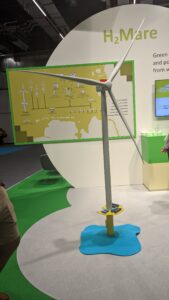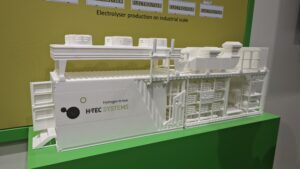
Direct conversion of wind power to hydrogen is being explored (photo source: Bailey)
The burgeoning hydrogen economy is taking center stage at Achema. In Hall 6.0, Stand A36, numerous industry experts are highlighting three flagship green-hydrogen initiatives that are set to re-shape the energy industry. Funded by Germany’s Federal Ministry of Education and Research (BMBF) to help achieve the targets of the country’s National Hydrogen Strategy, the projects cover the full hydrogen value chain from production to transport to storage and utilization. At the stand, a spinning model wind turbine (photo) illustrates the H2Mare project, which is exploring the potential to directly convert wind power into green hydrogen using a novel offshore configuration network, explains Dr. Jenz Artz – senior advisor, e-fuels and e-chemicals, Dechema. H2Mare consists of four joint projects that are set to run through March of 2025.
Visitors to the stand can also learn about the TransHyde project, which is focused on transport technologies and standards that will advance the infrastructure required to realize hydrogen economy goals.
Finally, the H2Giga project is focused on the heart of green-hydrogen production — the electrolyzer.

This model illustrates an industrial-scale installation of many modular electrolyzer stacks (Source: Bailey)
“Currently, electrolyzers can be considered almost hand-made. H2Giga covers everything that is needed to achieve hydrogen production on an industrial scale,” says Dr. Alexis Bazzanella, Project Management & Controlling, head of department at Dechema. Comprising 27 projects combined under one platform, H2Giga is focused on not only scaling up series production of electrolyzers and employing automated manufacturing techniques, but also is looking at lifecycle sustainability of electrolyzers, including the recyclability of materials and alternatives for expensive, rare materials. “To reach scale, it isn’t enough to consider the recyclability of electrolyzer materials. We must also begin to think about substituting out critical raw materials,” says Bazzanella, citing the prevalence of metals such as iridium and platinum, which are required in many electrolysis catalysts, as well as the avoidance of fluorinated compounds in membrane materials. At the stand, visitors can see a 3D-printed model of an industrial-scale electrolyzer stack installation, as well as close-up views of industrial electrolyzer cells, membranes and other critical components.
Note: This content was originally published as part of the Achema Official Show Daily